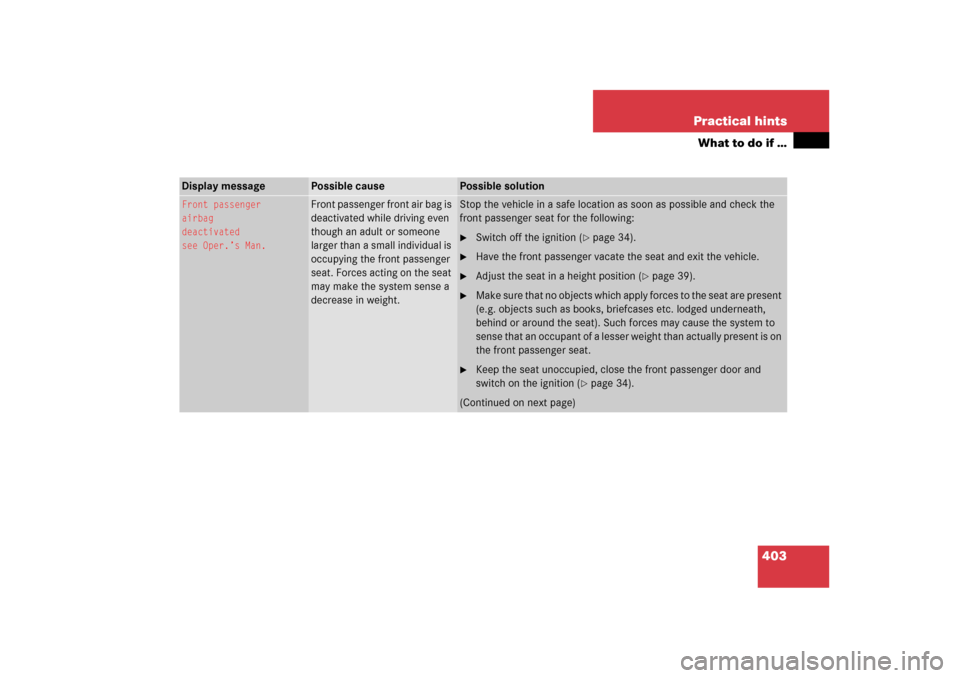Page 357 of 539

356 OperationTires and wheelsGeneral:
Depending on the design standards used,
the tire size molded into the sidewall may
have no letter or a letter preceding the tire
size designation.
No letter preceding the size designation
(as illustrated above): Passenger car tire
based on European design standards.
Letter “P” preceding the size designation:
Passenger car tire based on U.S. design
standards.
Letter “LT” preceding the size designation:
Light Truck tire based on U.S. design
standards.
Letter “T” preceding the size designation:
Temporary spare tires which are high
pressure compact spares designed for
temporary emergency use only.Tire width
The tire width1 (
�page 355) indicates
the nominal tire width in mm.
Aspect ratio
The aspect ratio2 (�page 355) is the
dimensional relationship between tire
section height and section width and is
expressed in percentage. The aspect ratio
is arrived at by dividing section height by
section width.
Tire code
The tire code3 (
�page 355) indicates
the tire construction type. The “R” stands
for radial tire type. Letter “D” means diag-
onal or bias ply construction; letter “B”
means belted-bias ply construction.
At the tire manufacturer’s option, any tire
with a speed capability above 149 mph
(240 km/h) can include a “ZR” in the size
designation (for example: 245/40 ZR 18).
For additional information, see “Tire speed
rating” (
�page 357).Rim diameter
The rim diameter4 (
�page 355) is the
diameter of the bead seat, not the
diameter of the rim edge. Rim diameter is
indicated in inches (in).
Tire load rating
The tire load rating5 (�page 355) is a
numerical code associated with the
maximum load a tire can support.
For example, a load rating of 91 corre-
sponds to a maximum load of 1 356 lbs
(615 kg) the tire is designed to support.
See also “Maximum tire load”
(
�page 361) where the maximum load as-
sociated with the load index is indicated in
kilograms and lbs.
Page 366 of 539

365 Operation
Tires and wheels
Tire and loading terminology
Accessory weight
The combined weight (in excess of those
standard items which may be replaced) of
automatic transmission, power steering,
power brakes, power windows, power
seats, radio, and heater, to the extent that
these items are available as
factory-installed equipment (whether
installed or not).
Air pressure
The amount of air inside the tire pressing
outward on each square inch of the tire.
Air pressure is expressed in pounds per
square inch (psi), or kilopascal (kPa) or
bars.
Aspect ratio
Dimensional relationship between tire
section height and section width
expressed in percentage.Bar
Another metric unit for air pressure. There
are 14.5038 pounds per square inch (psi)
to 1 bar; there are 100 kilopascals (kPa)
to 1 bar.
Bead
The tire bead contains steel wires wrapped
by steel cords that hold the tire onto the
rim.
Cold tire inflation pressure
Tire inflation pressure when your vehicle
has been sitting for at least three hours or
driven no more than one mile (1.6 km).
Curb weight
The weight of a motor vehicle with stan-
dard equipment including the maximum
capacity of fuel, oil, and coolant, and, if so
equipped, air conditioning and additional
optional equipment, but without passen-
gers and cargo.DOT (D
epartment o
f T
ransportation)
A tire branding symbol which denotes the
tire meets requirements of the
U.S. Department of Transportation.
GAWR (G
ross A
xle W
eight R
ating)
The GAWR is the maximum permissible
axle weight. The gross vehicle weight on
each axle must never exceed the GAWR for
the front and rear axle indicated on the
certification label located on the driver’s
door B-pillar.
GTW (G
ross T
railer W
eight)
The GTW is the weight of the trailer plus
the weight of all cargo, equipment, luggage
etc. loaded on the trailer.
Page 404 of 539

403 Practical hints
What to do if …
Display message
Possible cause
Possible solution
Front passenger
airbag
deactivated
see Oper.’s Man.
Front passenger front air bag is
deactivated while driving even
though an adult or someone
larger than a small individual is
occupying the front passenger
seat. Forces acting on the seat
may make the system sense a
decrease in weight.
Stop the vehicle in a safe location as soon as possible and check the
front passenger seat for the following:�
Switch off the ignition (
�page 34).
�
Have the front passenger vacate the seat and exit the vehicle.
�
Adjust the seat in a height position (
�page 39).
�
Make sure that no objects which apply forces to the seat are present
(e.g. objects such as books, briefcases etc. lodged underneath,
behind or around the seat). Such forces may cause the system to
sense that an occupant of a lesser weight than actually present is on
the front passenger seat.
�
Keep the seat unoccupied, close the front passenger door and
switch on the ignition (
�page 34).
(Continued on next page)
Page 430 of 539
429 Practical hints
What to do if …
Display symbol
Display messages
Possible cause
Possible solution
>
Level selection
not permitted
You are driving too fast for the desired
level selection.
�
Reduce vehicle speed.
�
Set the next higher level selection
again (
�page 250).
Compressor
cooling down
Level control was activated too long/too
frequently.
�
Let the compressor cool until the
message disappears.
The selected level will be set once the
compressor has cooled.
Visit workshop
The system display is malfunctioning.
�
Do not drive faster than 50 mph
(80 km/h) depending on the set vehi-
cle level.
�
Have the vehicle checked at an autho-
rized Mercedes-Benz Light Truck
Center.
!When the message
Compressor cool-
ing down
appears in the multifunction
display, driving is still possible.
Keep in mind that the ride height of the
vehicle is not yet reached, so you can
damage the underbody of the vehicle.
The selected level will be set once the
compressor has cooled.
Page 438 of 539

437 Practical hints
Unlocking/locking in an emergency
Unlocking and opening the tailgate
A minimum height clearance of 7 ft
(2.15 m) is required to open the tailgate.
If the tailgate can no longer be unlocked
and opened using the Œbutton on the
SmartKey or the KEYLESS-GO* function,
use the manual release to unlock and open
the tailgate.
The manual release is located on the inside
of the tailgate.
1Release lever
2Cover�
Remove cover2 from the trim on the
tailgate.
�
Push release lever1 all the way to the
left.
�
Lift the tailgate.!Always make sure there is sufficient
overhead clearance.iIf the vehicle has previously been
locked from the outside using the
SmartKey or SmartKey with
KEYLESS-GO*, opening the tailgate
from the inside will trigger the
anti-theft alarm system.
To cancel the alarm, do one of the
following:
With the SmartKey:�
Press buttonŒ or‹ on the
SmartKey.
�
Insert the SmartKey in the starter
switch.
With KEYLESS-GO*:�
Grasp an outside door handle.
The SmartKey with KEYLESS-GO
must be within 3 ft (1 m) of the ve-
hicle.
or
�
Press the KEYLESS-GO start/stop
button.
The SmartKey with KEYLESS-GO
must be inside the vehicle.
Page 492 of 539
491 Technical data
Main Dimensions
�Main Dimensions
Model
ML 350, ML 500
Overall vehicle length
188.5 in (4788 mm)
Vehicle width (exterior rear view mirrors folded out)
83.7 in (2127 mm)
Vehicle width (exterior rear view mirrors folded in)
76.0 in (1930 mm)
Overall vehicle height (vehicle with steel suspension)
71.5 in (1815 mm)
Overall vehicle height, depending on set vehicle level
(vehicle with air suspension package*)
69.8 in-73.0 in (1774 mm-1854 mm)
Wheelbase
114.8 in (2915 mm)
Track, front
64.0 in (1627 mm)
Track, rear
64.1 in (1629 mm)
Ground clearance (vehicle with steel suspension)
8.3 in (210 mm)
Ground clearance, depending on set vehicle level (vehicle
with air suspension package*)
7.1 in-10.3 in (181 mm-261 mm)
Turning radius
39 ft (11.6 m)
Page 502 of 539

501 Technical terms
ABS
(A
ntilock B
rake S
ystem)
Prevents the wheels from locking up
during braking so that the vehicle can
continue to be steered.
Accessory weight
(
�page 365)
ADS*
(Adaptive D
amping S
ystem*)
Automatically adapts the optimum sus-
pension damping to prevailing driving
conditions.
Air suspension*
Automatically selects the optimum sus-
pension tuning and ride height for your
vehicle. Air suspension consists of two
components:
�
Adaptive Damping System
�
Vehicle level control
Air pressure
(
�page 365)Alignment bolt
Metal pin with thread. The centering
pin is an aid used when changing a tire
to align the wheel with the wheel hub.
Aspect ratio
(
�page 365)
Bar
(�page 365)
BAS
(Brake A
ssist S
ystem)
System for potentially reducing braking
distances in emergency braking situa-
tions. The system is activated when it
senses an emergency based on how
fast the brake is applied.
Bead
(
�page 365)
Bi-Xenon headlamps*
Headlamps which use an electric arc as
the light source and produce a more
intense light than filament headlamps.
Bi-Xenon headlamps produce low
beam and high beam.CAC
(C
ustomer A
ssistance C
enter)
Mercedes-Benz customer service
center, which can help you with any
questions about your vehicle and
provide assistance in the event of a
breakdown.
CAN system
(C
ontroller A
rea N
etwork)
Data bus network serving to control
vehicle functions such as door locking
or windshield wiping.
Cockpit
All instruments, switches, buttons and
indicator/warning lamps in the
passenger compartment needed for
vehicle operation and monitoring.
Cold tire inflation pressure
(
�page 365)
Page 508 of 539

507 Index
A
ABS 93, 501
ABS control 93
Malfunction indicator lamp 382
Messages in display 397
Off-road - ABS 94
Warning lamp 382
Accelerator position, automatic
transmission 190
Accessory weight 365
Accident
In case of 59
Activating
Air circulation mode 226
Air conditioning (cooling) 211
Air recirculation mode 209, 224
Anti-theft alarm system 101
Central locking (control system) 172
Defrosting 208
Easy-entry/exit feature* 173
ESP
®
98Exterior headlamps 54
Hazard warning flasher 145
Headlamps 54
High beams 142
Ignition 34
Immobilizer 62, 100
Rear window defroster 201
Rear window wiper 58
Residual heat 212, 227
Seat heating* 134
Tow-away alarm 102
Warning indicators (Parktronic*) 256
Windshield wipers 55
Adaptive Damping
System (ADS)* 249, 501
Adding
Coolant 333
Engine oil 331
Additional turn signals 443Adjusting 38
Air distribution 207, 222
Air volume 207, 208, 222
Backrest tilt 40
Compass zone 171
Exterior rear view mirror 44
Head restraint height 40
Head restraint tilt 41
Headlamp aim 451
Instrument cluster illumination 148
Interior rear view mirror 44
Mirrors 43
Multicontour seat* 132
Seat cushion depth 132
Seat cushion tilt 40
Seat fore and aft adjustment 39
Seat height 39
Seats 38
Steering column height 43
Steering wheel 41
Adjusting steering column 43
ADS* 501